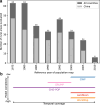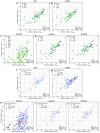Global gridded population datasets systematically underrepresent rural population
- PMID: 40102392
- PMCID: PMC11920052
- DOI: 10.1038/s41467-025-56906-7
Global gridded population datasets systematically underrepresent rural population
Abstract
Numerous initiatives towards sustainable development rely on global gridded population data. Such data have been calibrated primarily for urban environments, but their accuracy in the rural domain remains largely unexplored. This study systematically validates global gridded population datasets in rural areas, based on reported human resettlement from 307 large dam construction projects in 35 countries. We find large discrepancies between the examined datasets, and, without exception, significant negative biases of -53%, -65%, -67%, -68%, and -84% for WorldPop, GWP, GRUMP, LandScan, and GHS-POP, respectively. This implies that rural population is, even in the most accurate dataset, underestimated by half compared to reported figures. To ensure equitable access to services and resources for rural communities, past and future applications of the datasets must undergo a critical discussion in light of the identified biases. Improvements in the datasets' accuracies in rural areas can be attained through strengthened population censuses, alternative population counts, and a more balanced calibration of population models.
© 2025. The Author(s).
Conflict of interest statement
Competing interests: The authors declare no competing interests.
Figures









Similar articles
-
How accurate are WorldPop-Global-Unconstrained gridded population data at the cell-level?: A simulation analysis in urban Namibia.PLoS One. 2022 Jul 21;17(7):e0271504. doi: 10.1371/journal.pone.0271504. eCollection 2022. PLoS One. 2022. PMID: 35862480 Free PMC article.
-
Gridded population survey sampling: a systematic scoping review of the field and strategic research agenda.Int J Health Geogr. 2020 Sep 9;19(1):34. doi: 10.1186/s12942-020-00230-4. Int J Health Geogr. 2020. PMID: 32907588 Free PMC article.
-
The effects of spatial population dataset choice on estimates of population at risk of disease.Popul Health Metr. 2011 Feb 7;9:4. doi: 10.1186/1478-7954-9-4. Popul Health Metr. 2011. PMID: 21299885 Free PMC article.
-
GridSample: an R package to generate household survey primary sampling units (PSUs) from gridded population data.Int J Health Geogr. 2017 Jul 19;16(1):25. doi: 10.1186/s12942-017-0098-4. Int J Health Geogr. 2017. PMID: 28724433 Free PMC article.
-
Large-scale spatial population databases in infectious disease research.Int J Health Geogr. 2012 Mar 20;11:7. doi: 10.1186/1476-072X-11-7. Int J Health Geogr. 2012. PMID: 22433126 Free PMC article. Review.
Cited by
-
EpiGeoPop: a tool for developing spatially accurate country-level epidemiological models.Sci Rep. 2025 Jul 22;15(1):26663. doi: 10.1038/s41598-025-11999-4. Sci Rep. 2025. PMID: 40696036 Free PMC article.
References
-
- Islam, Md. S. et al. A grid-based assessment of global water scarcity including virtual water trading. Water Resour. Manag.21, 19–33 (2007).
-
- Deichmann, U., Meisner, C., Murray, S. & Wheeler, D. The economics of renewable energy expansion in rural Sub-Saharan Africa. Energy Policy39, 215–227 (2011).
-
- World Bank. Measuring rural access: using new technologies. https://documents.worldbank.org/en/publication/documents-reports/documen... (2016).
MeSH terms
LinkOut - more resources
Full Text Sources
Medical
Miscellaneous

